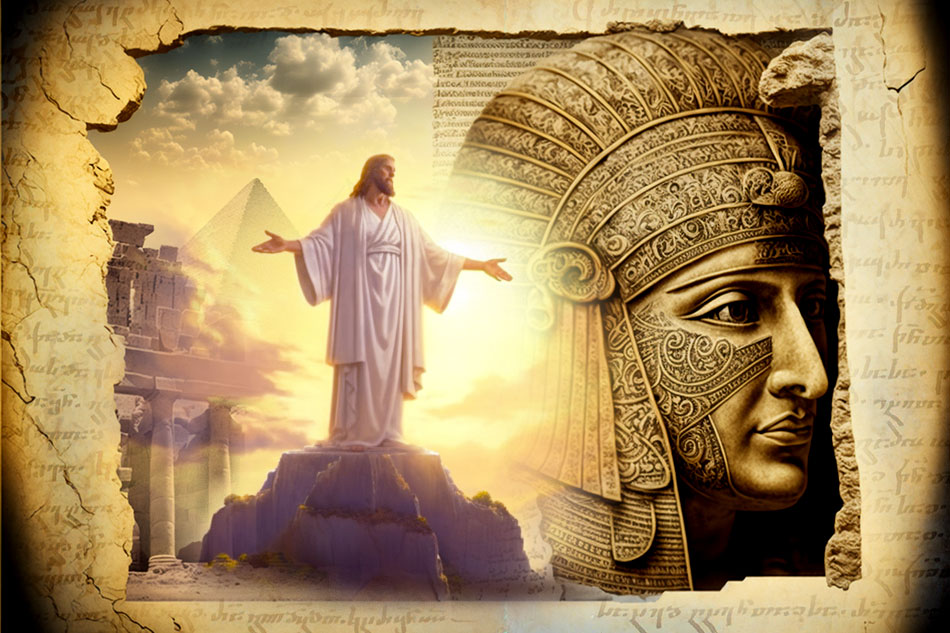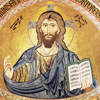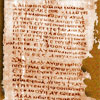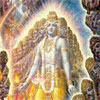The Lost Chord Of Christianity
 by Joe Fisher
by Joe Fisher
Put not off from day to day and from cycle to cycle, in the belief that ye will succeed in obtaining the mysteries when ye return to the world in another cycle.” – Jesus Of Nazareth (From the Gnostic Scirpture Pistis Sophia)
Everyone knows the annals of religious history are stained with blood and corruption. Few appreciate, however, that the ruthless expulsion of reincarnation from Christian thought and theology has left some of the deepest and most shameful stains of all time. Time has since worked its healing of forgetfulness and today most Christians are unaware that reincarnation was ever considered seriously by the church. But the fact remains that before Christianity became a vehicle for the imperial ambitions of Roman emperors, rebirth was widely accepted among the persecuted faithful.
Taught by a number of early church fathers and treasured by the Christian Gnostics, a movement in the apostolic tradition dedicated to preserving and promulgating the esoteric teachings of Jesus Christ, reincarnation was seen to be consistent with Old and New Testament scripture and complementary to the idea of personal salvation through Jesus Christ. From the earliest days of primitive Christianity, repeated earthly existences were a fact of life to many supplicants so long as they soldiered on in the quest for enlightenment. Yet they also believed that the monotonous cycle of birth and death could be transcended through the inspiration of Jesus Christ whose promptings towards spiritual perfection were able to exalt the individual to reconciliation with God and relief from the burden of the body.
The principal architect of this theological edifice was Origen, called “the prince of Christian learning in the third century” by St. Gregory of Nyssa, and hailed by the Encyclopedia Britannica as “the most prominent of the church fathers with the possible exception of Augustine.” While devoted to scriptural authority, Origen was also very much inclined towards the Platonic philosophy that had prevailed in Alexandria, the city of his birth, for more than four hundred years. He emphatically agreed with Plato that the divine eternal soul is cast into the corruptible body in order to prove itself superior to the inclinations of the flesh. Thus he wrote in a letter published in A Select Library of the Nicene and Post-Nicene Fathers of the Christian Church:
“If it can be shown that an incorporeal and reasonable being has life in itself independently of the body and that it is worse off in the body than out of it; then beyond a doubt bodies are only of secondary importance and arise from time to time to meet the varying conditions of reasonable creatures. Those who require bodies are clothed with them, and contrariwise, when fallen souls have lifted themselves up to better things their bodies are once more annihilated. They are thus ever vanishing and ever reappearing.”
In De Principiis, his major work and first systematic theology of Christianity, Origen declared:
“Every soul . . . comes into this world strengthened by the victories or weakened by the defeats of its previous life. Its place in this world as a vessel appointed to honor or dishonor, is determined by its previous merits or demerits. Its work in this world determines its place in the world which is to follow this.”
For Origen, whose faith brought him torture and imprisonment at the hands of the Romans in the last years of his life, and for other church fathers such as Justin Martyr, founder of the first Christian school in Rome, the scriptures were to be interpreted in the most expansive, allegorical way. The visionary breadth of Origen’s cosmic theology was not always appreciated by fundamentalists who cherished a narrow, literal reading of the scriptures. But the most telling opposition to the doctrine of reincarnation in Christian theology only developed once the church had evolved, in the fourth century, from harried bands of secret worshipers to an institution that could be exploited for political advancement and control.
The Abuse of Christianity
The seeds of reincarnation’s banishment were sown when Constantine the Great, the first Roman emperor to become a Christian, perceived his faith as the reason for his military supremacy. Before triumphing over the mightier forces of Maxentius at the Battle of Milvian Bridge in 312, he saw a cross of light superimposed on the sun, a vision that led him to believe he was Christianity’s chosen defender. As an expression of gratitude for this success, religious freedom was granted to all for the first time. And just as bemused Christians were beginning to accept that they were at last being tolerated by the authorities, Christianity had progressed from an illegal cult, whose members were hounded, abused and exterminated, to the official religion of the empire. Yet there was a high price to be paid for the gifts and favors Constantine lavished on the church: the ecclesiastical rock was to be sculpted strictly according to the emperor’s political designs. Ethics, faith and devotion became subordinate to the allure of personal interest and political power. Bishops were appointed not for their spiritual leadership but for what they could do to further Constantine’s aim of unifying the empire. For the first time in history, the church began to attract nominal Christians, those who attended for social, economic or political reasons rather than for the pursuit of righteousness.
Eager to safeguard what he understood to be the authentic Christian message, Constantine kept up the political pressure by calling the Council of Nicea in 325 to determine and define Christian orthodoxy. From then on, the powerful union of church and state—always dominated by the emperor’s wishes—decreed what was acceptable and what was heretical. Two lives were all that orthodoxy allowed—one life in the natural body and one hereafter in the form of resurrection. Bishops who disagreed with the council’s findings, and there were some notable renegades, were quickly deposed. Meanwhile, those devout Christians who were disenchanted with the secularization of the church initiated their own monastic movement. Tending to settle in the deserts not so much to get away from the world as to escape the world church, they set themselves the task of trying to preserve the Christian prototype, a religion as pure and simple as the Savior’s life.
This cleaving of the early church was accentuated in 380 when the establishment acted to outlaw and chastise freethinking Christians. The Edict of Thessalonica, decreed by Emperor Theodosius without consultation with the ecclesiastical authorities, vowed that “all peoples who fall beneath the sway of our imperial clemency should profess the faith which we believe to have been communicated by the Apostle Peter to the Romans and maintained in its traditional form to the present day.” The edict went further still . . .
“And we require that those who follow this rule of faith should embrace the name of Catholic Christian adjudging all others madmen and ordering them to be designated as heretics, condemned as such in the first instance to suffer divine punishment and therewith the vengeance of that power which we, by celestial authority, have assumed.”
In other words, heresy was no longer merely sinful; it was a crime, punishable by death. (Ironically, the word “heretic” means, at root, nothing more pernicious than one who is “able to choose.”) In 385, the first of a long line of reincarnationist martyrs fell to the barbarism of the church-state alliance when seven Spanish adherents of the Priscillian sect were found guilty by a Christian magistrate of erroneous belief. Yet for another one hundred and fifty years or more, there was no official edict condemning the doctrine of reincarnation across the empire. These desert Christians, many of them Gnostics or, at least, subscribers to Origen’s interpretation of the scriptures, led their lives with little interference from the prime movers of church policy. In the sixth century, however, increasing hostility towards Origen’s teaching culminated in the Emperor Justinian being asked to adjudicate in a dispute between Origenist and anti-Origenist factions in Palestine. Justinian gave his answer by convening a synod at Constantinople in 543 which condemned the teachings of Origen. (There must have been little doubt as to the outcome because Justinian had, in 529, closed the University of Athens, the last stronghold of Neoplatonism and, as such, a center of reincarnational study.) The emperor later issued fifteen “anathemas”—formal ecclesiastical curses involving excommunication—against Origen, four of which were aimed directly at pre-existence and, by implication, reincarnation. The first read:
“If anyone assert the fabulous pre-existence of souls, and shall assert the monstrous restoration which follows from it: let him be anathema.”
It is thought that Justinian submitted these official curses to a preliminary session of the unconstitutional Second Council of Constantinople in 553. Pope Vigilius, who had been Justinian’s prisoner for eight years, refused to participate in the deliberations and it was left to the attending bishops (representing, overwhelmingly, the Eastern church) to sanction the autocratic emperor’s wishes. Although there is no evidence that the curses against reincarnation were even discussed at the full ecumenical gathering, historians have for centuries mistakenly assumed that the Second Council proceeded to adopt them. In a sense, however, the question of official ratification is irrelevant. What matters is that ever since the ecumenical council of 553, the church has shunned the doctrine of rebirth.
Just why belief in reincarnation incurred the wrath of institutional authority is open to interpretation. But it seems likely that reincarnationists caused greatest offense by their self-reliance, which had the effect of minimizing the sway of their totalitarian masters. Believers in reincarnation were neither to be induced by promises of heavenly bliss nor intimidated by threats of hell fire; they didn’t need priests and ritual devices such as the confessional to guide them along the straight and narrow path to God. In toiling for their own salvation, they looked upon the church’s cultivated dependence of the masses as unnecessary. And this left the church fiercely intolerant of professing Christians whose subservience could not be guaranteed. Writes Hans Holzer in Patterns of Destiny: “The church needed the whip of Judgment Day to keep the faithful in line. It was therefore a matter of survival for the church not to allow belief in reincarnation to take hold among her followers.”
So it was that any departure from the official line was brutally punished by the guardians of orthodoxy. And yet, despite the menace of the most severe reprisals, including mass torture and execution, Christian sects clinging to their “heretical” beliefs proved themselves irrepressible. These sects were grouped together under the umbrella of Catharism (the religion of catharsis or purification), a term originally applied by St. Augustine to the reincarnationist Manicheans of Mesopotamia. The Cathars, who always believed themselves to be the true Christians, included the Paulicians of Thrace, the Bogomils of Bulgaria, the Patarenes of the Balkans and the Albigensians of southern France, while other groups flourished in northern Italy and Germany. Despite the fearsome vengeance of the Inquisition, which spared no effort to root out the rebels, Catharism “spread so rapidly and resisted so stubbornly the sternest efforts of suppression that at one time it may be fairly said to have threatened the permanent existence of Christianity itself,” comments Henry Lea in his History of the Inquisition of the Middle Ages. Linked with the Cathars were the Knights Templars, a Christian military order founded to protect pilgrims visiting the Holy Land, and the troubadours, traveling minstrels who wandered around Europe between the eleventh and thirteenth centuries popularizing the doctrine of reincarnation in their ballads. Simple love songs acted as lyrical disguises for tales of how well-spent lives were rewarded by rebirth in bodies suitable for further spiritual development.
As the church’s crusade of terror and slaughter was pursued to its bloody finale, the next life was increasingly all that was left to sing about. In 1244, the Albigensians were massacred to the last man, woman and child at their fortress of Montsegur in the Pyrenees. The church councils of Lyons in 1274 and Florence in 1439 drove home Justinian’s anathemas by affirming that souls go immediately to heaven, purgatory or hell. So thorough was the destruction of heretical works that most of what remains of Origen’s disputed discourses is only available because it was quoted in the arguments of his opponents! And much of that was first “smoothed” by his Latin translator, Rufinus, who admitted that he didn’t want to offend the church authorities. By the sixteenth century, reincarnational thinking had been routed from the public consciousness and the responsibility for smuggling the belief forward to the modern age was left to mystical groups such as the Alchemists and the Rosicrucians.
Biblical Testimony
Confirmation that reincarnation is indeed “the lost chord of Christianity” (a phrase attributed to William Q. Judge, a founder of the Theosophical Movement which has roots in Gnostic philosophy) can be found in the pages of the Bible. While the Old and New Testaments hardly trumpet the belief from the rooftops, there are numerous references to rebirth in both books. James M. Pryse asserts in Reincarnation in the New Testament (1900) that to dispute that the doctrine is distinctly taught in the New Testament “is to deny that the authors of that collection of writings meant what they said in unmistakable language.”
Several of the most explicit statements are made by Jesus Christ who affirmed his own pre-existence with the words “Before Abraham was, I am.” (John 8:58) In the presence of a man who was born blind, Jesus was asked by his disciples: “Master, who did sin, this man or his parents, that he was born blind?” Jesus answered: “Neither hath this man sinned nor his parents: but that the works of God should be made manifest in him.” (John 9:1-3) Although the disciples were clearly attributing prenatal existence to the blind man, Christ does nothing to correct or dispel this presupposition as he goes on to prepare a salve that restores the man’s sight. By refusing to challenge the disciples’ thinking, Jesus acknowledges the fact of pre-existence with its undeniable implication of reincarnation.
In the Gospel according to Matthew, chapter eleven, Jesus identifies John the Baptist as being Elijah reborn. Referring to the Old Testament prophecy that Elijah would appear before the coming of the Messiah, Jesus said: “This is he of whom it is written. . . . For all the prophets and the law prophesied until John. And if ye will receive it, this is Elias, which was for to come. He that hath ears let him hear.” Further on in the gospel account, Jesus underlines this assertion by declaring that “Elias has come already.” The disciples, Matthew points out, “understood that he had spoken of John the Baptist.” Both men, being big, boisterous and frenetically inspired, not only looked and dressed alike but also possessed the same character traits. Certainly, anything less than the absolute fusing of Elijah’s identity with John the Baptist undermines Christ’s claims to be the Messiah. The poet Robert Graves commented in a Playboy article in December, 1967: “No honest theologian can therefore deny that his acceptance of Jesus as Christ logically binds every Christian to a belief in reincarnation—in Elijah’s case, at least.”
St. Paul’s statement in his Epistle to the Galatians, “. . . whatsoever a man soweth, that shall he also reap” (Galatians 6:7) hints strongly at rebirth because one life is plainly insufficient for a perfect balancing of accounts. Likewise, verse ten in chapter thirteen of Revelation indicates karmic reprisal with all the portentousness of Hindu and Buddhist scripture: “He that leadeth into captivity shall go into captivity: he that killeth with the sword must be killed with the sword.” Given that many soldiers die quietly in their beds, these words suggest that retribution must be experienced in a future life.
The rebirth of Jacob and Esau is mentioned several times in both the Old and New Testaments. Before the children were born, “neither having done any good or evil,” God declares in Romans 9:13: “As it is written, Jacob have I loved but Esau have I hated.”
To complete this Biblical selection is a prayer of Moses, evocative of cosmic timelessness as well as the recurring cycles of human beings and nature:
“Thou turnest man to destruction; and sayest, Return, ye children of men. For a thousand years in thy sight are but as yesterday when it is past, and as a watch in the night. Thou carriest them away as with a flood; they are as a sleep: in the morning they are like grass which groweth up.” (Paslm 90:3-5)
If the Bible does little more than assume reincarnation this is because its contributors “might just as well give information regarding the digestive process, sleep or any other natural vital function,” according to G.A. Gaskell’s Dictionary of All Scriptures and Myths. More straightforward in its approach is the Gnostic gospel Pistis Sophia (meaning “knowledge-wisdom” and claiming to be the secret teachings of Jesus to Mary Magdalene) which quotes Jesus as saying that “souls are poured from one into another of different kinds of bodies of the world.”
The Aquarian Gospel of Jesus The Christ, having been transcribed from the Akashic Records during the last century by Levi, a pastor and medical doctor of Belleville, Ohio, cannot be classed as having the same scriptural authority as gospels with historical pedigrees. Nevertheless, the authenticity conveyed by the pages of this psychically transmitted work extends to a reincarnational passage in which Jesus, after listening to a group of youthful singers and musicians in Lahore, makes the following comment:
“These people are not young. A thousand years would not suffice to give them such divine expressiveness, and such purity of voice and touch.
“Then thousand years ago these people mastered harmony. In days of old they trod the busy thoroughfares of life, and caught the melody of birds, and played on harps of perfect form. And they have come again to learn still other lessons. . . . (Chapter 37:13-15)
Today’s leadership of the Protestant and Roman Catholic churches, although by no means eager to consider reincarnational belief for Christian adoption, must be well aware of the growing empathy it generates in ecclesiastical circles. Perhaps this warming trend harks back to the conversion of the Reverend William Alger in the second half of the last century. An energetic Unitarian minister who devoted half his lifetime to a work on immortality called A Critical History of the Doctrine of a Future Life, Alger dismissed reincarnation as a plausible delusion in the book’s first edition, published in 1860. But after further concentrated study he was so overpowered by the “peerless sublimity” of the doctrine that he gave rebirth his heartiest endorsement in the final edition, published in 1878. More recently, a number of leading clerics have spoken out in favor of reincarnation. In a 1957 lecture titled The Case For Reincarnation, Dr. Leslie Weatherhead, a former president of the Methodist Conference of Great Britain, declared:
“The intelligent Christian asks not only that life should be just, but that it shall make sense. Does the idea of reincarnation help here? . . . If I fail to pass those examinations in life which can only be taken while I dwell in a physical body, shall I not have to come back and take them again?”
A 1979 survey by the University of Surrey sociology department on attitudes among Britain’s Roman Catholics reported that an astonishing twenty-seven percent of Catholics believe in rebirth. An indication of the seriousness with which the establishment viewed this resurgence of the old heresy was the subsequent publication by the London-based Catholic Truth Society of a pamphlet titled simply Reincarnation by Father Joseph Crehan. Crehan states tersely: “ . . . Our faith has no room for theories of reincarnation.” Nor, it must be said, has the faith of fundamentalist Christians who, according to a September, 1982, editorial in the American magazine Reincarnation Report, are “using the same age-old manipulative fear-guilt-superstition formula to control the masses and perpetuate their own power.”
The battlements of the old guard will always be vigorously defended. But there’s no denying the undercurrent of partiality for reincarnation that could, unless confronted sympathetically, create quite a disruption in the halls of conformity. California theology professor Dr. Pascal Kaplan—who in 1972 was refused permission to write his Harvard doctoral dissertation on rebirth because, in the words of his rejecter, “no one connected with theology in the West since the third century has taken reincarnation seriously”—is fascinated by the recent surge of reincarnational interest. He points out that there’s a growing network of priests, nuns and ministers who, in accepting reincarnation, believe that an understanding of rebirth “provides a framework for a deeper, truer understanding of their religion and of the essence of Christian spirituality.” According to Kaplan, many advocates play “very significant” roles within the church hierarchy.
It may be just a matter of time before one of these individuals argues his or her position too loudly to be ignored by the establishment church, thus precipitating the public airing this bottled-up issue has long demanded. Meanwhile, the lost chord awaits its rehabilitation in the symphony of the ages.
Excerpt from The Case For Reincarnation
Posted in Other Topics, Reincarnation, The True Life of Jesuswith comments disabled.





